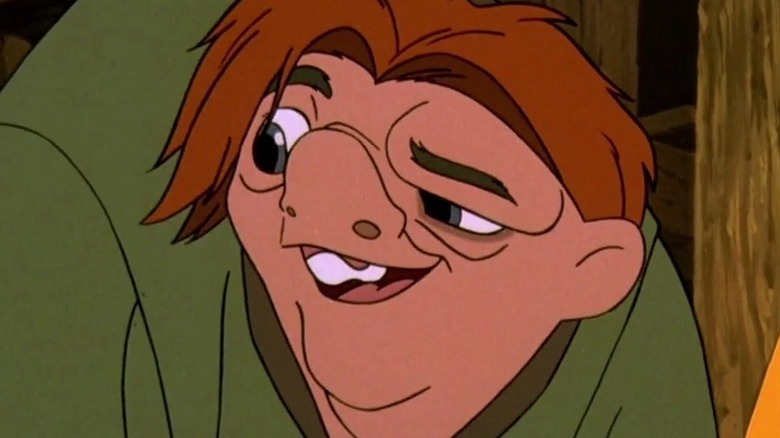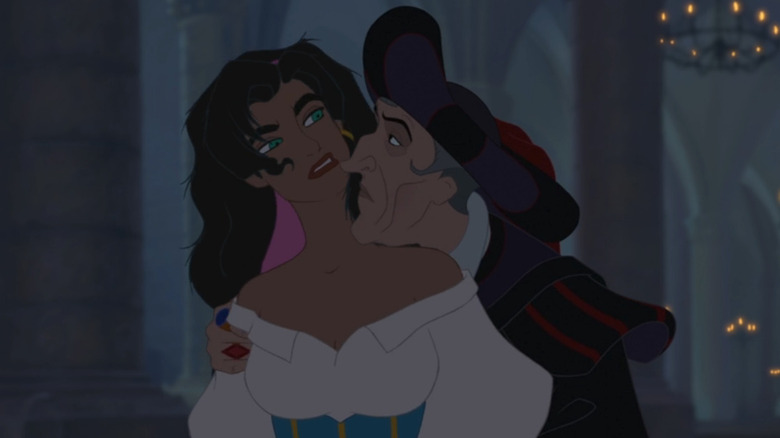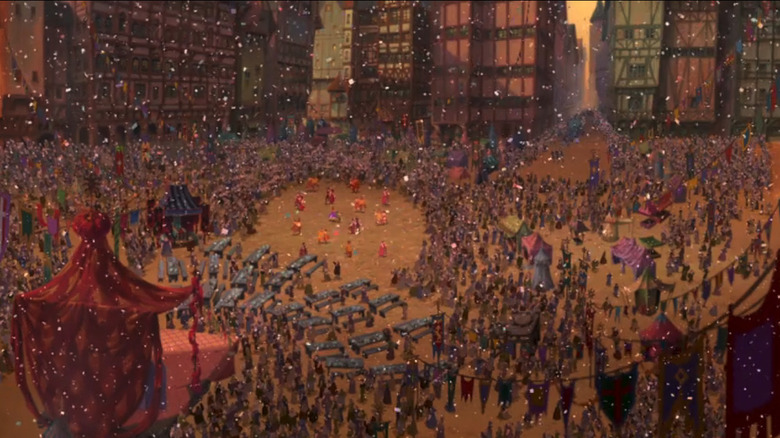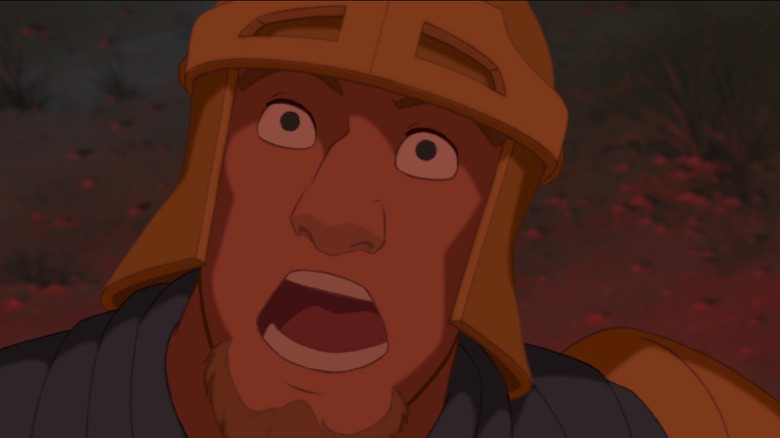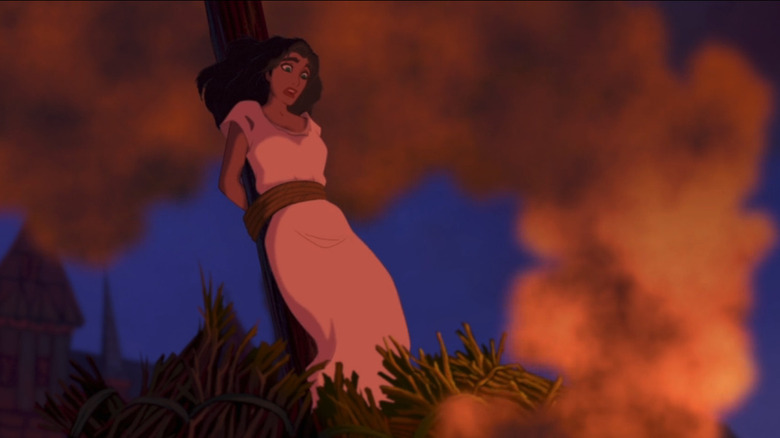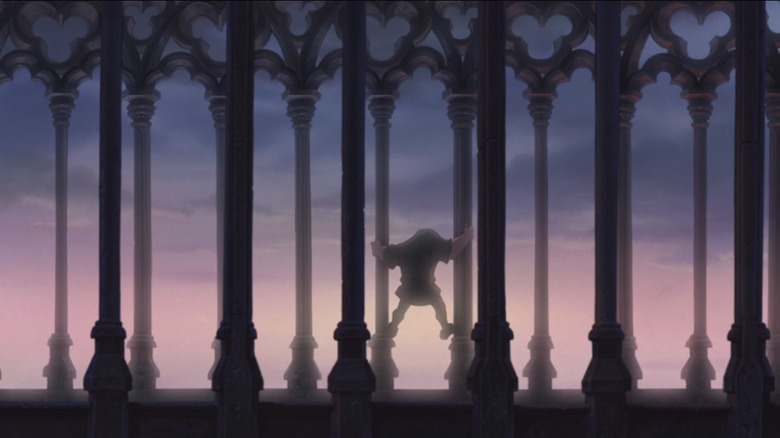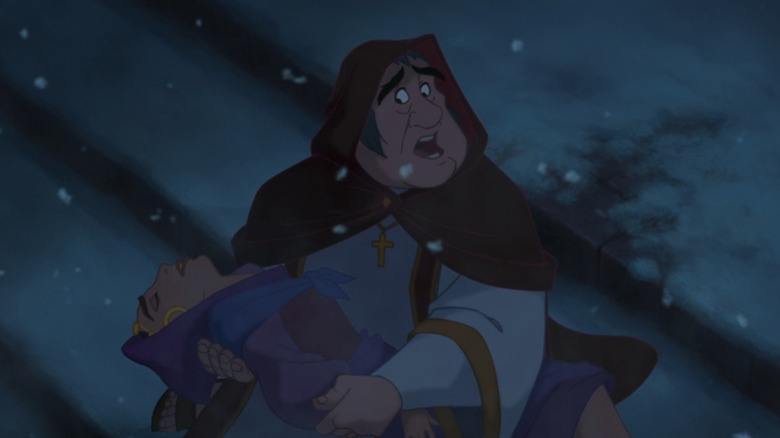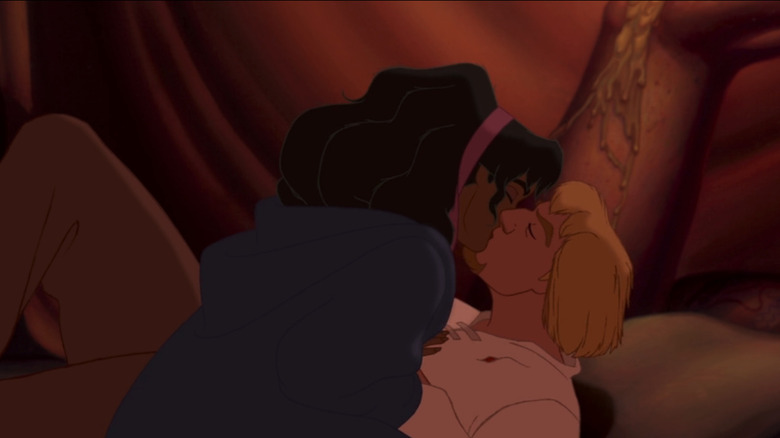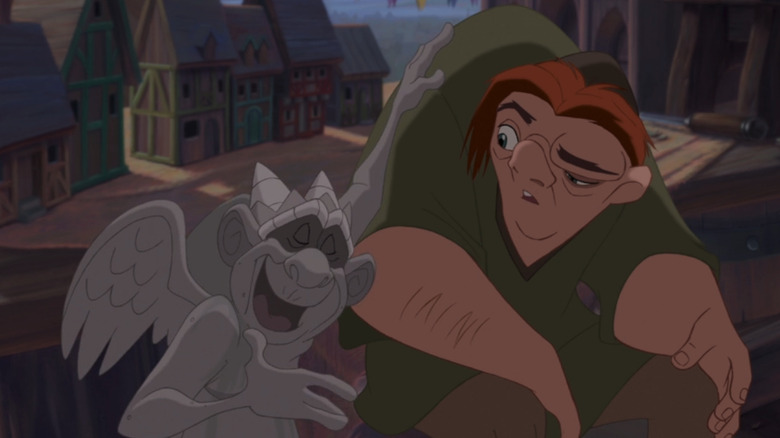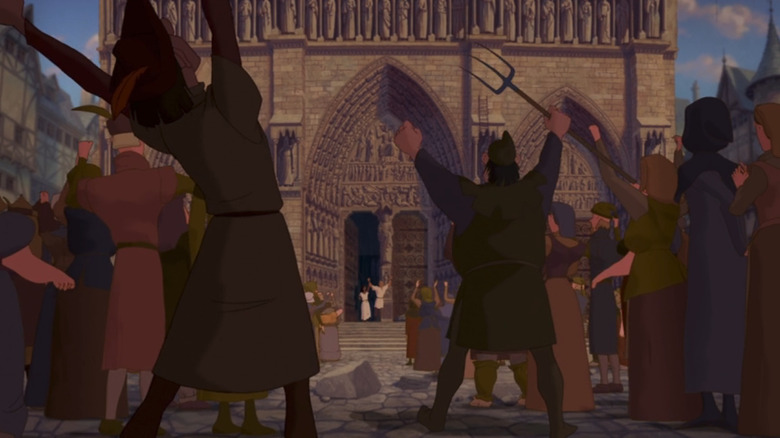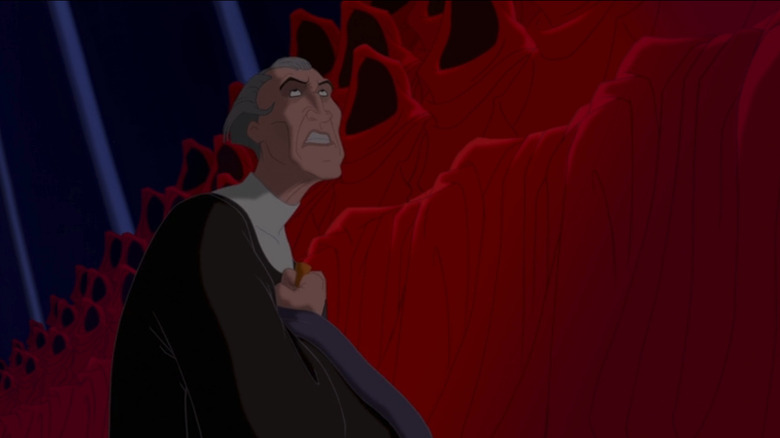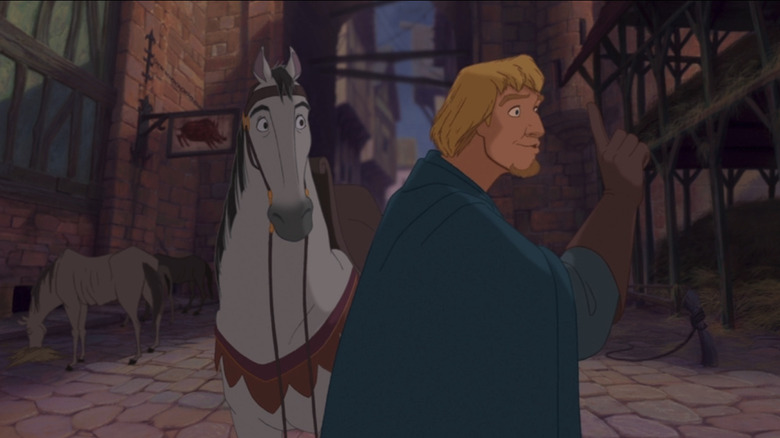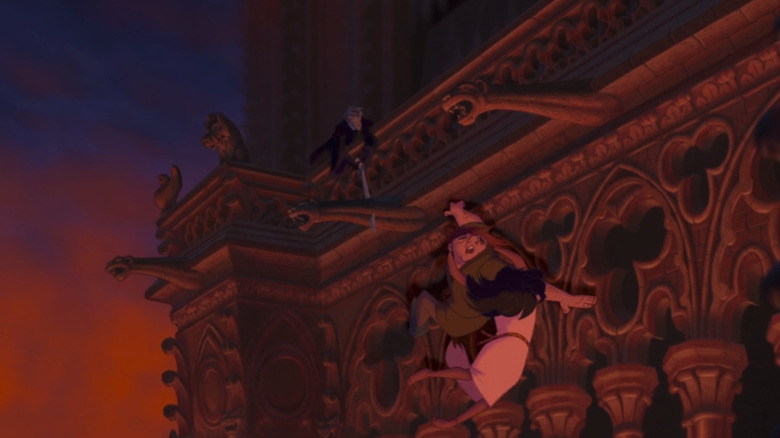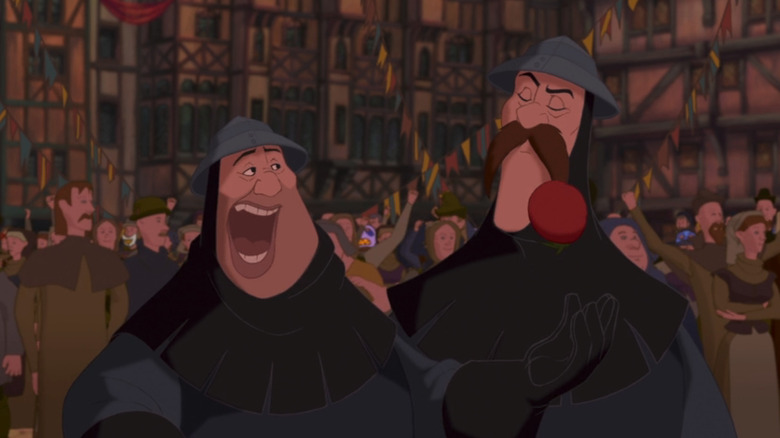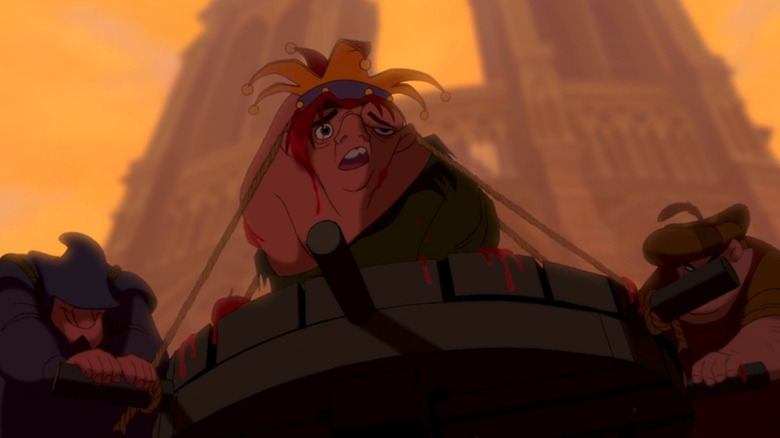Things Only Adults Notice In Disney's The Hunchback Of Notre Dame
Released in 1996, "The Hunchback of Notre Dame" has a well-earned reputation as one of the darkest films in Disney's animated canon. Adapting Victor Hugo's classic novel of the same name, the Disney film tells the story of a young bellringer named Quasimodo. Isolated from the outside world because of his physical difference and the controlling vice-grip of his guardian, judge Claude Frollo, Quasimodo dreams of walking the streets of Paris with the sun on his face. One day, at the urging of his gargoyle pals, Quasimodo sneaks out of Notre Dame to attend the Festival of Fools. There, he meets a street-smart Roma dancer named Esmeralda, who shows him the kindness he has been denied his entire life. Meanwhile, the sadistic Frollo — who abhors the Roma and intends to exterminate them from "his" city — is troubled by his own attraction to the enchanting woman.
Due to its intense scenes and more challenging thematic concerns (as far as Disney goes), "The Hunchback of Notre Dame" is a film that definitely hits differently as an adult. In that spirit, here is a list of things that you only really pick up on when watching "The Hunchback of Notre Dame" as a grown-up.
A core theme is sexual repression leading to violence
One of the more obvious ways that "The Hunchback of Notre Dame" earned its reputation for being more mature than most Disney animated films is that one of its core themes is super dark. Namely, the film contains the extremely adult idea that there's a direct correlation between sexual entitlement and violence. Judge Frollo lusts after Esmeralda, which makes him feel all icky because he hates the Roma people. Sure enough, the sexual shame crosses Frollo's wires, and this manifests as an unhealthy desire to possess or destroy. Because Frollo doesn't grant Esmeralda the dignity of personhood (to him the Roma are no better than an ant infestation), he's free to objectify her both as a piece of property and as an abstract concept.
That said, in this context possession and destruction might as well be the same thing. Rebuked (because he's a big old creep and trying to eradicate Esmeralda's people, among other things), Frollo goes on a rampage, burning down half of Paris in the process. If this sounds a bit incel-ish to you, then you would be right. It's never too early to teach kids about how losers who feel like they are owed sex might commit acts of terrorism if they feel scorned.
If you or anyone you know has been a victim of sexual assault, help is available. Visit the Rape, Abuse & Incest National Network website or contact RAINN's National Helpline at 1-800-656-HOPE (4673).
There's some sneaky CGI integration
If you're a wee one watching "The Hunchback of Notre Dame," you're probably not thinking about the film's role in the larger history of Disney's integration of CGI into traditional animation. As for us older folk, especially those of us who have retained an appreciation of animated films into adulthood, the presence of CGI in "The Hunchback of Notre Dame" — most notably in the swooping camera and the CGI-enhanced crowd scenes — is part of a much bigger picture.
Co-created with Pixar in the late 1980s, Disney's Computer Animation Production System, also known as CAPS, allowed animators to speed up many of the more laborious processes of traditional animation. However, the first Disney animated feature film to significantly integrate CGI took place earlier than CAPS' inception: 1986's "The Great Mouse Detective" used computer generated imagery to enhance the climactic brawl in the cogs of London's iconic Big Ben. A couple of years later, CAPS would be used in earnest in 1989's "The Little Mermaid," for the final rainbow sequence. The presence of CGI integration was even more noticeable in the following year's "The Rescuers Down Under," which used digital coloration and camerawork to save significant money and time.
The film has an all-star voice cast
Now look, there's definitely a chance that there's some cinephile child prodigy out there who knows and cares about voice casts on feature animated films. But let's be honest, the vast majority of kids who watched "The Hunchback of Notre Dame" weren't leaning in towards the end credits exclaiming: "Oh wow, 'Seinfeld' star Jason Alexander voiced one of the gargoyles? Cool!"
As an adult, having a bit of outside knowledge about the cast of "The Hunchback of Notre Dame" is a delight. As the kind-hearted, big dreamer Quasimodo, Tom Hulce provides a stark contrast to the role that he's most known for: The giggling, chaos-loving Mozart in 1984's multi-Oscar nominated "Amadeus." Moving along, Phoebus' sardonic charm has an extra wrinkle to it if you're familiar with the work of Kevin Kline, who dominated zany romantic comedies like "A Fish Called Wanda" in the 1980s. Likewise, adults in the audience would no doubt get a kick out of Esmeralda's erotically-charged performance at the Festival of Fools given Demi Moore's other 1996 release: "Striptease." Youngsters don't always associate animated characters with the actors who play them. But, unfortunately for us older lot, obsessive pre-show IMDb checking is a curse of adulthood.
It's toned down compared to the book
"The Hunchback of Notre Dame" is easily one of the most mature traditionally-animated Disney films ever made. In addition to its weighty subject matter — which tackles everything from genocide to psychological torture to, uh, literal torture — the film contains a lot of explicitly upsetting sequences. There's death, carnage, menace, and a mean spirit you don't typically see in Disney films. But, if you're an adult who is familiar with Victor Hugo's text, you'll know that for all its bite, this is the toned down version of the tale.
There are a lot of differences between Hugo's novel and the Disney film, many of which were clearly made to tone things down and avoid ruffling feathers. In the book, for instance, Frollo is a priest rather than a judge, a key difference with spicy implications that Disney was clearly interested in side-stepping. In the book, Phoebus isn't a heroic charmer, but a minor antagonist whose interest in Esmeralda is purely carnal. Another key change has to do with Quasimodo himself.
In addition to his physical difference, in Hugo's text, Quasimodo is half-deaf and blind from his life in the bell tower. Another notable difference between the text and Disney's film is the lack of corpses once the dust settles. In the book, Quasimodo, Esmeralda, and Frollo all die horribly violent deaths. Quasimodo's death is especially upsetting. In the epilogue his skeleton is discovered in a mass grave, with the implication being he was on the hunt for Esmeralda's corpse.
The music is incredible
It's definitely true that appreciation for the music of "The Hunchback of Notre Dame" is a thing that intensifies with age. With its obvious influences in choral music, opera, and the musical traditions of pre-Reformation Catholicism, Stephen Schwartz and Alan Menken's score is one of the least pop-y in Disney's canon. Many of the songs are dark and emotional, with lyrics that foreground narrative plot points instead of statements of fact or abstract feelings.
"The Bells of Notre Dame" — a prologue framed as a puppet show told by the clownish narrator Clopin — introduces us to both our protagonist's tragic backstory and the film's key thematic concern ("Who is the monster/and who is the man?"). Both of Quasimodo's solos, "Out There" and "Heaven's Light," are text-dense and feature terrific vocal gymnastics from Tom Hulce. Even the more comically-inclined numbers ("Topsy Turvy" and "A Guy Like You") have a certain edge to them, a degree of chaos that makes them feel like the crescendo of a chorus line rather than something you'd hear a five-year-old kid humming. All told, the soundtrack rules, even more so once you have the attention span to digest all the lyrics (and the life experience to realize that "Hellfire" is probably a nod to "Te Deum" from Giacomo Puccini's "Tosca").
The film has a lot of explicit peril and violence
If you showed a kid "The Hunchback of Notre Dame," they would definitely pick up on the fact that the film contains a lot of upsetting content (or as the IMDb Parents' Guide puts it: "Frightening or intense scenes"). But, as an adult, knowing what adults know, the sum total of all the peril and violence is genuinely shocking, even if you're into that sort of thing. Many Disney animated films have maybe one or two notorious scenes — the tragic death of a parent (like in "The Lion King" or "Bambi") or a shockingly violent villain death (like in "Snow White and the Seven Dwarves" or "Tarzan"). But, in comparison, "The Hunchback of Notre Dame" makes those films look like a cakewalk.
Before the opening credits even roll, a Roma woman dies with her head smashed in on the steps of a church and her baby is narrowly saved from being chucked down a well after it's discovered he has a physical difference. There is active, unflinching talk of genocide with respect to the Roma people. It's overtly implied that Frollo is a masochist (his smile at the sound of a whip crack during a torture scene is simultaneously disturbing and the funniest joke in the movie). Not only that, but we've got a barely-averted public immolation to top it all off (several, actually, if we count the scene where Frollo nearly burns two children alive in a farmhouse). How this film got a G rating remains a real mystery.
The protagonist doesn't end up with their love interest
It's tricky to pinpoint where exactly the shift happened, but at some point in the 21st century, Disney decided that it was no longer interested in telling traditional "happily ever after" love stories. Maybe the turning point was the meta-comedy of 2007's partially-animated "Enchanted," or maybe the self-aware smirk of 2000's "The Emperor's New Groove" is to blame. We say "blame" like this shift was a bad thing. It isn't, necessarily.
"The Hunchback of Notre Dame" is where these winds of change first started to blow. If you're familiar with Victor Hugo's text, you'll know that, love-sick though he may be, Quasimodo doesn't get the girl. While in Disney's take the end result is decidedly less morbid, Quasimodo's flying solo holds true. At the end of the film, Esmeralda is happily paired up with the blonde, square-jawed Captain Phoebus, who fits the Disney Prince mold in a way that Quasimodo can't.
There's actually a solid thematic rationale for Quasimodo getting the cold shoulder. Where Judge Frollo handles Esmeralda's rejection by burning down half of Paris, Quasimodo shows an admirable degree of emotional intelligence for someone who grew up in a bell tower. When the reality of Esmeralda and Phoebus' attraction is made plain to him, Quasimodo gives himself a moment to be upset, and then he moves on. You know, like an adult. And really, his emotional journey is about liberty, not romantic love. It makes perfect sense that he'd respect Esmeralda's autonomy and just be jazzed about his new-found freedom.
The gargoyles were probably a figment of Quasimodo's imagination
While there's probably some fancy pants child out there who doesn't care for the gargoyles' antics, generally speaking, their comic relief is specifically for the benefit of younger viewers. Their purpose is to lighten the mood between all the genocide and Catholic guilt. As many adult viewers are quick to note, the gargoyle comedy is one of the weaker parts of the film. The silly voices, armpit farts, and implied goat-love (wait, didn't we say earlier that the gargoyles were for kids?) are tonally jarring. But get this: There is a way of injecting a little bit of darkness into their zany antics.
In Victor Hugo's text, it's stated outright that Quasimodo talks endlessly to the inanimate stone gargoyles for company. And as an adult watching the Disney film, it's clearly implied that Quasimodo's gargoyle pals are just figments of his imagination. Not only do we see him personify the bells when he's showing Esmeralda around ("She likes you!"), early in the film, the gargoyles back off from Quasimodo, reminding him that they are "just part of the architecture." As an adult, free from the gargoyles' goofy spell, it's pretty obvious that all these silly antics are actually just the hallucinations of a lonely prisoner, which is incredibly sad.
Paris must have an enthusiastic clean up crew
Now, we don't know if you noticed, but the third act of "The Hunchback of Notre Dame ” is mostly just flames. In his genocidal quest to eradicate the Roma people from Paris (but, more specifically, to murder the woman who won't let him touch her), Judge Frollo has transformed the city into a fiery vision of Hell itself. And while this is thematically appropriate, turning a city into a bonfire is bound to leave a stain or two. And yet, when the smoldering torrent of flame dies down come morning, Paris looks spic and span. There isn't an ounce of soot in sight. Not a singed thatched roof as far as the eye can see. Heck, there isn't even a Frollo-sized crater in Place du Parvis Notre-Dame.
Of course, Paris being instantly cleansed and restored after the sadistic judge kicked the bucket makes sense in terms of Disney-logic. It could even be argued that the miraculous clean-up job was a literal act of God, evaporating Frollo's corruption to provide our heroes with the unblemished send-off they deserve. Quasimodo stepping over Frollo's flattened corpse wouldn't really gel with the Disney brand. Then again, maybe the French just have incredible civic janitorial staff.
Hellfire is even darker if you know Latin
Thematically rich, disturbing, and — dare we say it — catchy, "Hellfire" is a pained diatribe on the part of Frollo, who is wrestling with his depraved, fleshy feelings for Esmeralda. As the song begins, the evil judge confesses his burning passion for Esmeralda into the roaring fireplace. Addressing Mary, the virginal mother, Frollo discloses that he cannot reconcile his sanctimonious self-image with his "sinful" desire for this sexy lady. He's a good, god-fearing guy, he swears. So why does he feel these "wicked" feelings? Of course, there's only one thing to do: Have her all to himself or murder her for the sin of being so dang attractive.
A Latin chorus chants in the background of the song. And if you don't actually know Latin, you'd be forgiven for thinking it was just a way to underscore the religious overtones of Frollo's unhealthy contrition (which, even on its own, is kind of spicy for a Disney film). But, if you do know Latin, "Hellfire" becomes even darker.
As Frollo gives his half-apology, the chorus lays out a sincere confession that places the blame squarely on the judge ("And to you, Father/That I have sinned/In thought/In word and deed"). Later, when the tempo picks up and Frollo blames Esmeralda for being too hot ("It's not my fault/I'm not to blame"), the chorus punctuates each of the judge's lines with a mea culpa ("Through my fault"), crescendoing in a mea maxima culpa, which means exactly what you think it does. Finally, before Frollo's call to action ("She will be mine/or she will burn!"), the chorus pleads for Frollo's soul ("Lord have mercy"). Like we said — dark stuff.
Both of the lead horses have very silly names
Not all of the comedy in "The Hunchback of Notre Dame" works, but both of the film's "hero" horses have hilarious names. We hear the name of Phoebus' white horse, Achilles, repeatedly. Like many Disney animated horses, Achilles is basically a dog. So, at several points, Phoebus commands Achilles to "sit" on various foes. And, early after his introduction, Phoebus asks Achilles to "heel," meaning that we are treated to the delightful phrase, "Achilles, heel!" For those shaky on their anatomy or Ancient Greek mythology, the Achilles' Heel refers to an especially vulnerable tendon. Is it a silly pun? Yes. Does it have anything to do with the story? No. Did it sail over our heads as children? Absolutely.
Sneakier still (and arguably funnier) is the name of Judge Frollo's intimidating steed. In the director's commentary on the film's DVD, co-directors Kirk Wise and Gary Trousdale along with producer Don Hahn revealed that the Friesian's name is Snowball. This is funny for two reasons. First, naming a pitch-black horse after something notoriously white is objectively funny. Second, there is something absolutely glee-filled about the idea of a cruel, lecherous, sadist like Frollo naming his evil-looking horse something so adorable. Then again, given that Frollo orders his archers to avoid his horse during Phoebus' escape, it could be that Snowball is one of the few living creatures that Frollo truly loves.
Frollo's sword is wildly sharp
"The Hunchback of Notre Dame" is far more grounded in reality than the vast majority of its animated peers: There's no magic, no talking animals, and even a general respect for the laws of physics. Indeed, this feeling of realism is a big part of what makes "The Hunchback of Notre Dame" feel like a much darker entry in the Disney canon. That said, if you were paying close attention during the violent balcony climax, high up on the edge of Notre Dame, you may have noticed that Frollo's sword doesn't exactly behave like a regular sword.
While Quasimodo and Esmeralda scamper precariously down the gnarled stone ledge, a wild-eyed, gray-faced Frollo follows, blade at the ready. Given that Frollo is a svelte older man, it's a miracle that he can raise his huge sword at all, let alone swing it. However, not only does the deranged judge do both of these things, he brings the blade down with such force that he slices through a stone gargoyle like it was nothing more than a rotten stump of wood. Two things are possible here. One: The sword is supernaturally light and ridiculously sharp. Two: Those gargoyles are not very well-made. In our opinion, the latter option is far more likely, especially given that one crumbles under Frollo's weight. Clearly these things weren't built to last.
The film has a bunch of historical inaccuracies
To be clear, there's nothing wrong with taking a few creative liberties here and there. After all, it makes sense to play fast and loose with fiddly historic details if it serves the story. But, if you're an adult familiar with history, you might not be able to help yourself in noticing some of the historical inaccuracies in "The Hunchback of Notre Dame."
One example of a historical tweak that absolutely serves the story is the presence of steps leading up to the doors of Notre Dame de Paris (which means "Our Lady of Paris," in case you were wondering). While no such steps exist in front of the real-life cathedral, there's no denying that the stairs add a certain degree of drama, particularly during the introductory scene where Frollo assaults and kills Quasimodo's mother.
Another inaccuracy takes place during the tonal turn of the Festival of Fools, when the crowd pelts Quasimodo with tomatoes. Victor Hugo's tale takes place in the late 15th century, and Spanish conquistadors didn't return to Europe from South America with the fruit until the 16th century at the earliest. Similarly, while we see Djali (Esmeralda's goat) smoking a pipe, tobacco wasn't introduced to France until the mid-16th Century. Though, to be honest, the tobacco not being historically accurate makes the content warning on Disney+ about smoking all the more hilarious.
There are several visual nods to the 1939 live-action film
The heyday of "The Hunchback of Notre Dame" adaptations is long behind us (unless Disney's upcoming live-action film kicks off a revival). If you're a connoisseur of older cinematic adaptations of Victor Hugo's text (which probably pegs you as a grown-up), you're likely familiar with William Dieterle's 1939 adaptation. Famously starring the great English-American actor Charles Laughton as Quasimodo, the 1939 film is responsible for a good deal of the visuals and key scenes in the Disney version. Laughton's makeup is clearly an inspiration for animated Quasimodo's design. Many of the scenes play out almost identically, including the Festival of Fools and the iconic cry for "sanctuary!" Most striking, perhaps, are the visual similarities between the scene where Quasimodo is tied to a breaking wheel and publicly humiliated. Truly, the list goes on and on.
In addition to visual nods, the Disney version also took cues from the 1939 version in terms of how to adapt Hugo's story for a wider audience. Dieterle's film also envisioned Frollo as a judge instead of a priest. Likewise, the classic live-action flick added a scene of Esmeralda praying in Notre Dame (to emphasize her goodness, of course) and merged the characters of Clopin and Pierre Gringoire into one character. Disney also seems to have keyed into the 1939 film's interest in the tale's core theme of social injustice and persecution. All told, if you're a fan of Disney's "The Hunchback of Notre Dame," you'd do well to seek the 1939 version out.
